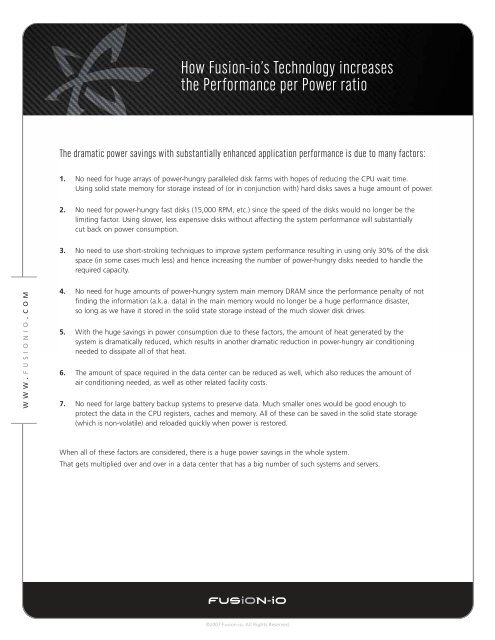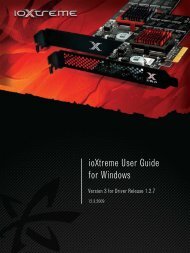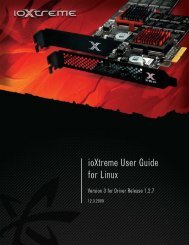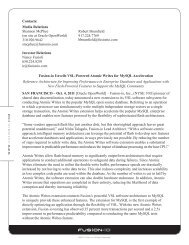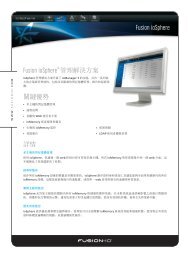Taming the Power Hungry Data Center - Fusion-io
Taming the Power Hungry Data Center - Fusion-io
Taming the Power Hungry Data Center - Fusion-io
Create successful ePaper yourself
Turn your PDF publications into a flip-book with our unique Google optimized e-Paper software.
How <strong>Fus<strong>io</strong>n</strong>-<strong>io</strong>’s Technology increases<br />
<strong>the</strong> Performance per <strong>Power</strong> rat<strong>io</strong><br />
The dramatic power savings with substantially enhanced applicat<strong>io</strong>n performance is due to many factors:<br />
1. No need for huge arrays of power-hungry paralleled disk farms with hopes of reducing <strong>the</strong> CPU wait time.<br />
Using solid state memory for storage instead of (or in conjunct<strong>io</strong>n with) hard disks saves a huge amount of power.<br />
2. No need for power-hungry fast disks (15,000 RPM, etc.) since <strong>the</strong> speed of <strong>the</strong> disks would no longer be <strong>the</strong><br />
limiting factor. Using slower, less expensive disks without affecting <strong>the</strong> system performance will substantially<br />
cut back on power consumpt<strong>io</strong>n.<br />
3. No need to use short-stroking techniques to improve system performance resulting in using only 30% of <strong>the</strong> disk<br />
space (in some cases much less) and hence increasing <strong>the</strong> number of power-hungry disks needed to handle <strong>the</strong><br />
required capacity.<br />
WWW. FUSIONIO. COM<br />
4. No need for huge amounts of power-hungry system main memory DRAM since <strong>the</strong> performance penalty of not<br />
finding <strong>the</strong> informat<strong>io</strong>n (a.k.a. data) in <strong>the</strong> main memory would no longer be a huge performance disaster,<br />
so long as we have it stored in <strong>the</strong> solid state storage instead of <strong>the</strong> much slower disk drives.<br />
5. With <strong>the</strong> huge savings in power consumpt<strong>io</strong>n due to <strong>the</strong>se factors, <strong>the</strong> amount of heat generated by <strong>the</strong><br />
system is dramatically reduced, which results in ano<strong>the</strong>r dramatic reduct<strong>io</strong>n in power-hungry air condit<strong>io</strong>ning<br />
needed to dissipate all of that heat.<br />
6. The amount of space required in <strong>the</strong> data center can be reduced as well, which also reduces <strong>the</strong> amount of<br />
air condit<strong>io</strong>ning needed, as well as o<strong>the</strong>r related facility costs.<br />
7. No need for large battery backup systems to preserve data. Much smaller ones would be good enough to<br />
protect <strong>the</strong> data in <strong>the</strong> CPU registers, caches and memory. All of <strong>the</strong>se can be saved in <strong>the</strong> solid state storage<br />
(which is non-volatile) and reloaded quickly when power is restored.<br />
When all of <strong>the</strong>se factors are considered, <strong>the</strong>re is a huge power savings in <strong>the</strong> whole system.<br />
That gets multiplied over and over in a data center that has a big number of such systems and servers.<br />
©2007 <strong>Fus<strong>io</strong>n</strong>-<strong>io</strong>, All Rights Reserved.


